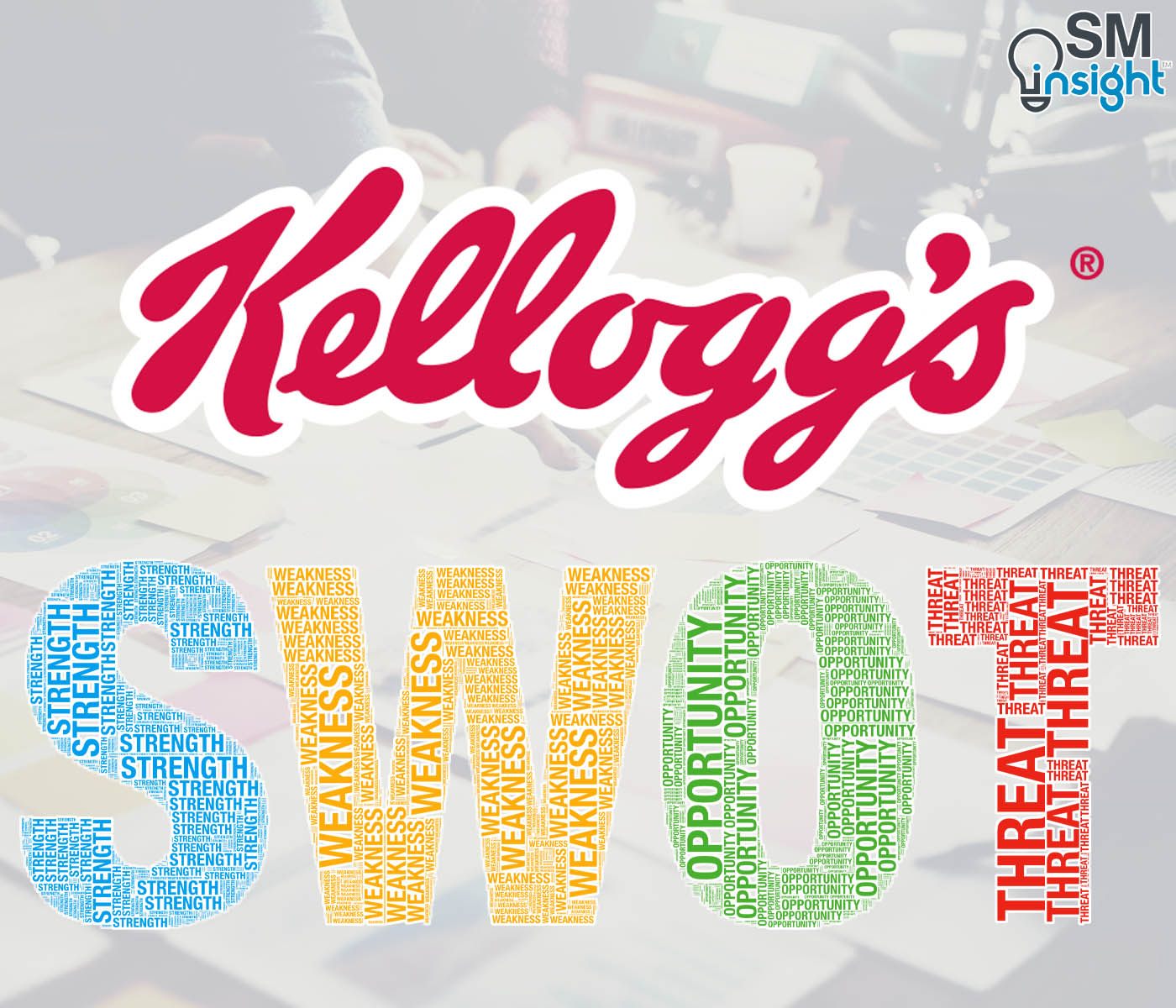This SWOT analysis of Kellogg’s examines the brand by its strengths, weaknesses, opportunities, and threats. The report assesses the internal and external factors affecting Kellogg’s business environment while looking at its current and future potential.
Company Overview
| Company name | Kellogg’s |
| Founded | 1898 |
| Logo |  |
| Industry | Consumer packaged foods |
| Geographic areas served | 180 countries |
| Headquarters | Battle Creek, Michigan |
| Current CEO | Gary Pilnick |
| Revenue | $10.71 billion (2024) |
| Net Income | $0.365 billion (2024) |
| Number of employees | 24,000 (2024) |
| Main competitors | General Mills, Kraft Heinz, PepsiCo, Seneca Foods, Tyson Foods, Mondelez International and Nestle. |
Company Background
Founded in 1898, Kellogg’s is the leading producer of ready-to-eat cereals and other convenience snack foods in the USA. Headquartered in Battle Creek, Michigan, the company was one of the earliest and still remains one of the most popular breakfast cereals in the United States.
With sales of over $15.3 billion for the year ending 2022, Kellogg Company remains the world’s leading producer of cereals and a leading producer of convenience foods, including cookies, crackers, toaster pastries, cereal bars, fruit-flavored snacks, frozen waffles, and veggie foods. The company’s products are manufactured in 18 countries and marketed in more than 180 countries.
Starting with just one product, the Kellogg Company added many other items over the years, with a laser focus on sugar-coated cereals targeted at children while also offering bran and other healthy grains to adults.
Much more recently, the company has moved beyond cereal, selling snack bars and other foods that can be eaten on the run. In 2022, its snacks segment had the highest profit margin at 17.54%, with the cereal segment trailing behind at 10.42%.
Although the plant segment has a high margin of 14.71%, it remains quite small in size. The company’s largest market share is in the Cereal Production industry, where they account for an estimated 27.5% of total industry revenue.
Figure 1: EBITDA to sales ratio by segment
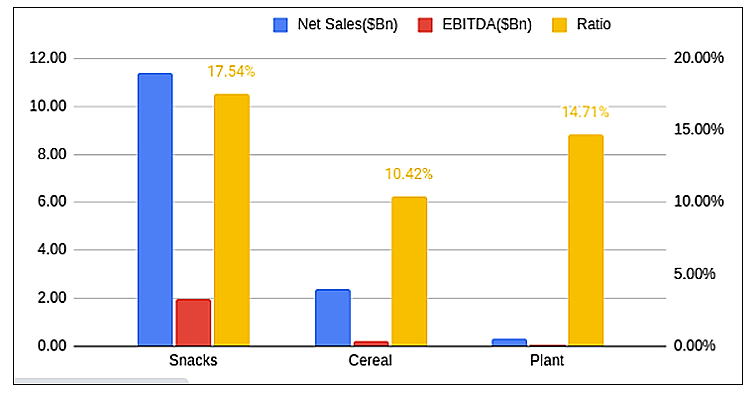
While the Kellogg Company’s sales volumes rose in North America in the third quarter of 2022, they fell in overseas regions, with company executives asserting that the company was starting to see some consumer pushback against higher prices in Europe.
In terms of market share, Kellogg’s is the second biggest cereal company in the USA. In 2022, it commanded 25% of all dollars spent on cereal in the market with $2.3 billion in sales as shown in fig. 2 (below).
Figure 2: Market share of Kellogg’s cereal and top competitors
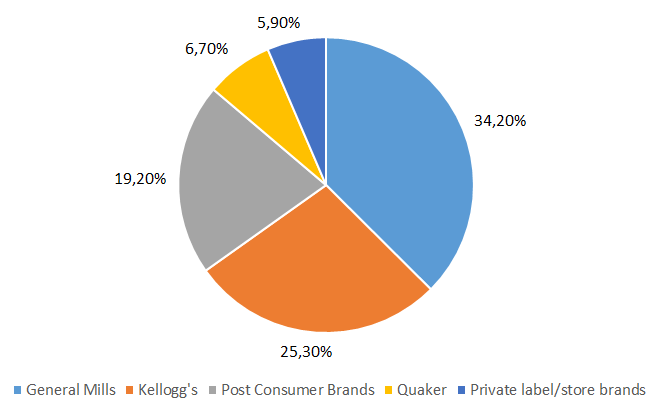
However, some of Kellogg’s recent share decline is attributable to a major fire at a plant in 2021 and a nearly three-month strike at all four of its cereal plants last fall. Its unit sales fell more than 14% over the previous year.
Figure 3: Net sales of the Kellogg Company worldwide from 2004 to 2021(in million U.S. dollars)
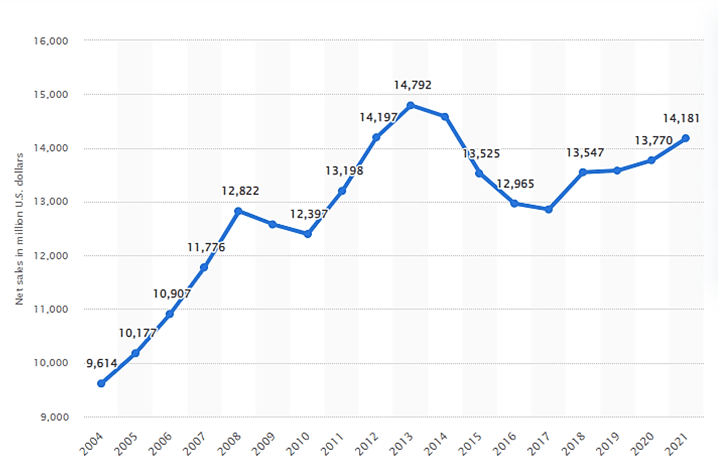
Kellogg’s SWOT Analysis
| Strengths | Weaknesses |
|---|---|
| 1. Broad product portfolio 2. Good acquisitions enable it to strengthen its market reach and optimize the use of resources 3. Kellogg’s offers consumer accessibility and instant gratification on mobile 4. Flexibility in sourcing and distribution strategies 5. Significant international exposure | 1. Increasingly high prices 2. Dwindling sales for morning cereals 3. Some of the company’s cereals have been rendered unhealthy by FDA 4. Declining margins |
| Opportunities | Threats |
|---|---|
| 1. Cost-Of-Living Crisis is an opportunity for innovating in snacking 2. Promoting sustainability in production and packaging 3. Increased interest in healthier foods 4. Wider use of automation in day-to-day activities and the supply chain | 1. Inflation and its impact on production and packaging of the products 2. Impact of Russia Ukraine geopolitical tension 3. Escalating food prices 4. Consumers are becoming more receptive to private-label products |
Strengths
1. Broad product portfolio
Kellogg’s has created some of the most popular brands in the world: Froot Loops, Frosted Flakes, Special K, Rice Krispies, Pop Tarts, Eggo Waffles, Nutri-Grain Bars, and Kellogg’s Corn Flakes, the most popular cereal ever created. Because of its broad portfolio, Kellogg’s is able to satisfy the different needs of different consumer segments irrespective of their age group and needs.
From consumers seeking super indulgence – like having real chocolate in their cereal, to those seeking healthy options, Kellogg’s vast portfolio allows it to speak to consumers where they are.
2. Good acquisitions enable it to strengthen its market reach and optimize the use of resources
Through strategic acquisitions, Kellogg’s has been able to strengthen its market reach and optimize the use of resources. Over the years, Kellogg’s has acquired key and strategic companies that have helped it grow and expand its market reach – in terms of customer segments and regions.
In 2012, the company acquired Pringles for $2.7 billion in a cash deal, making it second only to PepsiCo Inc. in the global snack food market[1]. Today, the snacks segment is one of the fastest growing at a time morning cereals are slowing down. For the year 2022, the company’s snack business, fueled by price realization, was its engine for growth both at home in the United States and globally[2].
In 2021, the snacking business was responsible for about 80% of the company’s net sales.
- Entry into the healthy snacks market: To gain traction with consumers focused on health and nutrition, the company has made several acquisitions of more health-focused brands, like RXBAR, which it acquired for $600 million in 2017[3].
- Expansion into Africa: In 2018, Kellogg’s acquired a stake in packaged food manufacturer Tolaram Africa Foods (TAF), – a subsidiary of Tolaram Group – for $420 million, as a way of expanding its market reach in the African market.
3. Consumer accessibility and instant gratification on mobile
Kellogg Co. has launched a new mobile and Web experience that integrates into the company’s loyalty program to make it simpler for consumers to receive rewards.
Mobile is a natural way for the brand to speed up its loyalty-building efforts since mobile streamlines the entire redemption process and can therefore propel more consumers to participate.
4. Significant international diversification
Kellogg’s business has significant international diversification. In 2022, its international sales (outside of North America) accounted for 41.5% of total company revenue, while North America accounted for 58.5%. This reflects an ever-expanding share of international sales and growth, and shrinking sales growth in North America.
Figure 4: Sales of Kellogg’s by region (2022)
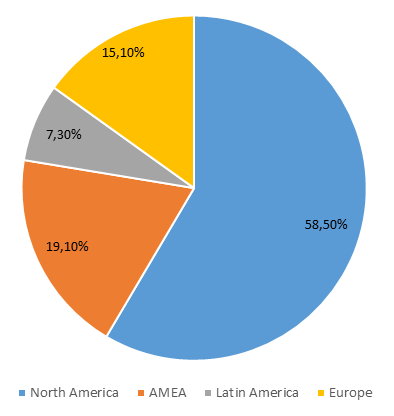
Its international diversification has put it at a great advantage. As sales in the U.S. start to slow down, its international sales are gaining growth momentum and offsetting the sales in the North American cereal segment.
5. Flexibility in sourcing and distribution strategies
A flexible supply chain has enabled Kellogg’s to react swiftly to disruptions, allowing it to lessen its liability, maximize profit, and mitigate supply chain risks. Because of its flexible sourcing and distribution strategy, Kellogg’s was able to quickly source suppliers closer to home in order to overcome global disruptions brought about by the pandemic[4].
Weaknesses
1. Price hikes
Like most other packaged food makers globally, Kellogg’s increased product prices in order to counter spiraling costs that characterized the post-pandemic era. However, as inflation continues to escalate and consumers tighten their spending budgets, the company is likely to hit a ceiling on price hikes.
If Kellogg’s continues to pass cost increases onto the consumer irrespective of consumer pushback, its profits could suffer as consumers cut back spending[5].
2. Dwindling sales for morning cereals
The popular brands, which the company has relied on for more than 100 years, have fallen out of favor with today’s more health-conscious consumer, resulting in decreased sales across Kellogg’s portfolio of products.
Stated another way, the products that brought Kellogg’s to life as a company now have the potential to severely weaken and even kill the company. The new reality for Kellogg’s is that being the best cereal company in the world no longer matters.
3. Some of the company’s cereals have been rendered unhealthy by FDA
Kellogg’s cereals Special K, Frosted Mini-Wheats, and Raisin Bran have been on the list of cereals that are no longer considered a healthy breakfast by the U.S. Food and Drug Authority (FDA). Its cereals have added sugars and more sodium than new FDA-proposed health standards.
For instance, Raisin Bran has 9 grams of added sugar; Frosted Mini-Wheats has 12 grams. While Special K only has 4 grams of added sugar, it still has 270 milligrams of sodium.
As consumers continue to seek healthier snack options, the sales of morning cereals could further dwindle, impacting the company’s sales in the U.S.
Declining margins
Kellogg’s gross profit margin has been at its lowest since before the last recession, while other margins have also decreased in 2022. Although its earnings exceeded expectations in the latest quarter of 2022, its growth is not keeping up with revenue growth.
Figure 5: Margin analysis 2013-2022
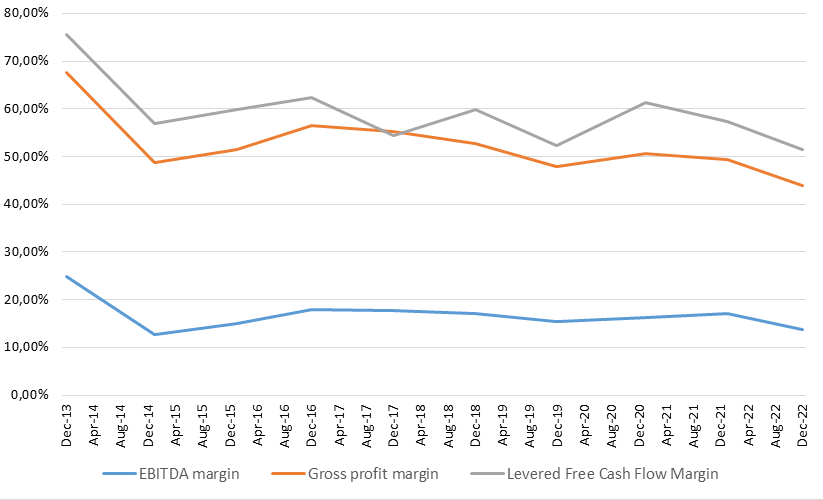
In December 2022, Kellogg’s gross profit margin hit its 5-year low of 30.2%. Kellogg’s gross profit margin decreased in 2018 (35.6%, -4.9%), 2019 (32.6%, -8.3%), 2022 (32.2%, -6.2%), and 2022 (30.2%, -6.2%) and increased in 2021 (34.3%, +5.1%).
Kellogg’s EBITDA margin decreased in 2018 (17.1%, -3.4%), 2019 (15.4%, -10.1%), and 2022 (13.7%, -20.3%) and increased in 2021 (16.3%, +6.2%) and 2022 (17.1%, +4.9%).
Kellogg’s levered free cash flow margin decreased in 2019 (4.3%, -38.6%), 2022 (8.1%, -24.7%), and 2022 (7.6%, -6.2%) and increased in 2018 (7.1%, -1,027.5%) and 2021 (10.8%, +147.5%).
As shown in the figure 5 above, the decline in the ratios indicates that the costs and expenses side is growing too fast in that the fast growth of revenue could not compensate for them.
Opportunities
1. Cost-Of-Living crisis is an opportunity for innovating in snacking
As prices continue to go up while disposable incomes shrink further, consumer behavior is also changing. For instance, research in the U.K. has shown that families are spending £1,200 a year on snacks despite the current financial crisis in the country.
A study by Cracker brand Jacobs also found that people are spending a fifth of their total food budget on snacks. This is most probably because snacks are cheaper than real meals. For instance, at the same price, you can buy double the amount of crisps, chocolate, and fizzy juice compared to fruits and smoothies[6].
Experts have forecast that this issue will not stop any time soon. This trend is an opportunity for Kellogg’s to innovate in its snack segment.
2. Promoting sustainability in production and packaging
While sustainability has been top of mind for food and beverage processors and consumers for many years, this is expected to be an even greater priority in 2023. In a recent IDC industry survey, at least 30% of food and beverage decision-makers considered customer demand for eco-friendly products and offerings as the top factor motivating organizational change toward greater sustainability.
A McKinsey Survey showed that more than 50% of U.S. consumers are greatly concerned about the environmental impact of packaging, and nearly 70% are willing to pay extra for eco-friendly packaging. GlobalData Survey also showed almost a third (30%) of global consumers actively look for product packaging that is either biodegradable, plastic-free, reusable, or made from renewable resources. It is thus important to promote sustainability in packaging across various industries.
Positive climate action is increasing in urgency and consumers are growing ever more conscientious about how their own decisions, including the brands they support, are impacting the environment and the health of the planet. Furthermore, inflation, increased competition, and supply chain challenges increase the need for food and beverage manufacturers to continue to strengthen their commitments to operational sustainability.
Alongside proving that its products are good value for money, Kellogg’s could reflect on how it can convey its environmentally friendly credentials for maximum brand benefit.
3. Increased interest in healthier foods
Today’s consumers are taking more care about what they put into their bodies and seek foods that can deliver multiple health benefits in one bite. Moving forward, consumers don’t want food that just looks and tastes good.
They are also looking at the role particular food items play in promoting good health and well-being. Kellogg’s should adapt to this trend by investing in healthier snacks as well as functional foods and marketing their health benefits.
This way, the company will be able to rejuvenate sales and grow its market share, especially in markets like USA, where sales have been slowing down in the morning cereals, the company’s most profitable segment.
4. Acceleration in snacking (snackification) is an opportunity to innovate
Gaining momentum because of Americans who replaced most of their sit-down meals with a snack on the run, ‘Snackification’ is a major trend that will continue to shape the packaged foods industry irrespective of the living cost crisis.
The convenience and portability of snacks are key, primarily due to time pressures and the growing on-demand culture. Boosted by millennials who have less interest in cooking and are too busy to sit down and eat, this trend is an opportunity for Kellogg’s to launch new formats of their bestselling brands[7].
A focus on healthy snacks can play a major role in further growth, especially in developed markets where healthy snacks have gained importance, offering further snackification opportunities to innovate in permissible indulgence.
5. Wider use of automation in day-to-day activities and the supply chain
From labor shortages, disrupted supply chains, and ongoing strikes in the food and beverage industry, automation should be a key priority to maintain consumer trust and avoid potential labor shortages. Modernizing manufacturing operations in terms of smart, connected factory, access to real-time data and full visibility will mitigate supply chain risks, reduce liability and boost profitability.
Threats
1. Inflation and its impact on production and packaging
According to Euromonitor International’s estimates, global inflation was forecast to reach 8.9% in 2022 and 6.2% in 2023. In this context, the food industry is currently faced with the challenge of rising costs of production, including raw materials, commodities, labor, energy, and transportation.
This could, in tandem, continue to force Kellogg’s to pass down these costs to the consumer in the form of high prices, which could, at some point, result in consumer pushback and affect the company’s revenue and profitability.
2. Impact of Russia Ukraine geopolitical tension
The war between Russia and Ukraine has been a major factor behind the inflation of global food prices. According to Euromonitor International (2023), packaged food categories that are heavily dependent on cereals, such as bread, pasta and breakfast cereals, will continue to be affected by the prolonged Russia-Ukraine geopolitical tensions.
Considering that Russia and Ukraine are the breadbaskets of Europe, accounting for 29% of global wheat exports, 80% of the world’s sunflower oil, and 40% of barley, prices are expected to remain high in the near future.
In the case of sweet spreads, prices will continue to be affected, considering one-third of Europe’s honey imports traditionally stems from Ukraine[8]. This will continue to increase the costs of production for packaged foods, forcing companies to push costs down to the consumer who is already struggling due to inflation.
3. Escalating food prices
As the Ukrainian war continues to suppress food production, coupled with droughts in Europe and Africa, on top of floods in countries such as Pakistan, these factors have contributed to high food prices and shortages worldwide.
Combined with a rise in fertilizer and labor costs, these issues have created inflationary pressures[9]. A case in point – Thai rice, a benchmark for Asia, has soared to the highest in almost two years due to strong demand, with some importers buying more of the grain to replace wheat after the war in Ukraine disrupted supplies.
Some consumers have also been stocking up ahead of festivals, while a strengthening Thai currency has also helped to push up dollar-denominated prices[10].
Labor shortages: In addition to rising fuel prices, another rising input cost for farmers has been labor. Since the pandemic, labor shortages in many parts of the world have been driven by changes in immigration laws, restrictions on seasonal work visas and a declining interest in agricultural employment.
In Ukraine, the war has displaced farm workers, leading to uncertainty over harvests. In certain countries, including the U.K., ongoing labor shortages, driven by an increasing number of people becoming economically inactive or foreign workers returning to their home countries during the COVID-19 pandemic, have led to unharvested crops spoiling, disruptions that have led to higher food prices and more food imports.
On top of that, aging populations in Asia and Western Europe are further contributing to labor shortages as it becomes increasingly difficult to replace retiring agricultural workers.
4. Consumers are becoming more receptive to private label products
With living expenses taking a larger cut of consumers’ paychecks, private-label products are starting to take spending away from national staple brands. The Consumer Price Index, a key barometer of inflation, rose 7% year-over-year in December 2022, the largest annual increase since June 1982, according to recent data from the Labor Department of the USA.
During the same period, costs for several categories, including household furnishings and operations, apparel, and food increased. With living expenses taking a larger cut of consumers’ paychecks, private-label products may take spending away from national staple brands.
There are already signs that customers are buying more private-label products. For instance, Target’s owned brands grew 36% in the first quarter of 2021, the strongest the company has ever recorded. In March 2021, Kroger reported a record 13.6% year-over-year to $26.2 billion sales increase for its store brands. This is a major threat for Kellogg’s, especially now that it has increased its prices in order to counter the increasing production costs. This could, in time, result in customers opting for more affordable brands.
5. Tightening supply chains
The recent surge in demand for energy, labor, and transport has placed significant pressure on Just-In-Time ordering and cross-border supply chains that keep factories open and shelves stocked. With supply chain problems set to continue well into 2023, Kellogg’s is likely to continue experiencing high costs of production, which will likely impact profitability unless passed on to already struggling customers bearing already high costs of living. The high prices could push away customers, and this would also hurt profitability.
Conclusion
As household budgets, especially those for lower-income consumers, continue to feel the pinch of high inflation, Kellogg could start to lose out to cheaper store-brand cereals as consumers seek out cheaper options.
Nevertheless, Kellogg’s established brand name and vast international exposure will continue to give it a competitive advantage in the increasingly competitive market. As growth in the U.S. market continues to dwindle, its international businesses, especially in developing countries, will continue to play a major role in its future growth.
The growing demand for snacks is also an opportunity for innovation and growth. Investment in automation will also play a major role in reducing costs and mitigating supply chain issues.
Sources
[1] Geller, M. and Wohl, J. (2012). Kellogg to buy Pringles for $2.7 billion. Reuters. Available Online at https://www.reuters.com/article/us-kellogg-pringles-idUSTRE81E0S620120215
[2] Sosland Josh (2022). Kellogg snack sales growing rapidly. Food Business News. Available Online at https://www.foodbusinessnews.net/articles/21298-kellogg-snack-sales-growing-rapidly
[3] Ladd Brittain (2019). Cereal Killer: Kellogg’s Must Transform Its Company to Survive—Will It Succeed?. Observer. Available Online at https://observer.com/2019/05/kellogg-cereal-company-transformation-survival/
[4] Ferrari Bob (2021). Kellogg’s $45 Million Supply Chain Restructuring- Efficiency or Transformation? Supply Chain Matters. Available Online at https://theferrarigroup.com/kelloggs-45-million-supply-chain-restructuring-efficiency-or-transformation/
[5] Brewer, R., Gregg. (2022). This Is the Biggest Hurdle Challenging Kellogg’s Growth Right Now. The Motley Fool. Available Online at https://www.fool.com/investing/2022/08/19/this-is-the-biggest-hurdle-challenging-kelloggs-/
[6] Blakeway Jay (2023).People Spending Over £1,000 a Year on Snacks During Cost of Living Crisis. Glasgow Standard. Available Online at https://glasgowstandard.com/2023/03/23/people-spending-over-1000-a-year-on-snacks-during-cost-of-living-crisis/
[7] Hyslop Gill (2023). State of Snacking Report: Snackification is Alive and Well Despite Cost Of Living Crisis. Bakery and Snacks. Available Online at https://www.bakeryandsnacks.com/Article/2023/01/20/State-of-Snacking-report-Snackification-is-alive-and-well-despite-cost-of-living-crisis
[8] Euromonitor International (2023). How Consumers and Businesses are Reacting to Food Price Inflation. Available Online at https://www.euromonitor.com/article/how-consumers-and-businesses-are-reacting-to-food-price-inflation
[9] Barclays (2023). War and extreme weather threaten fragile food supply chains. Available Online at https://www.cib.barclays/our-insights/global-food-systems-under-mounting-pressure.html
[10] Tanakasempipat Patpicha(2023). Soaring Rice Price Shows Food Inflation Still Stalking the World. Bloomberg. Available Online at https://www.bloomberg.com/news/articles/2023-01-27/soaring-rice-price-shows-food-inflation-still-stalking-the-world?leadSource=uverify%20wall

